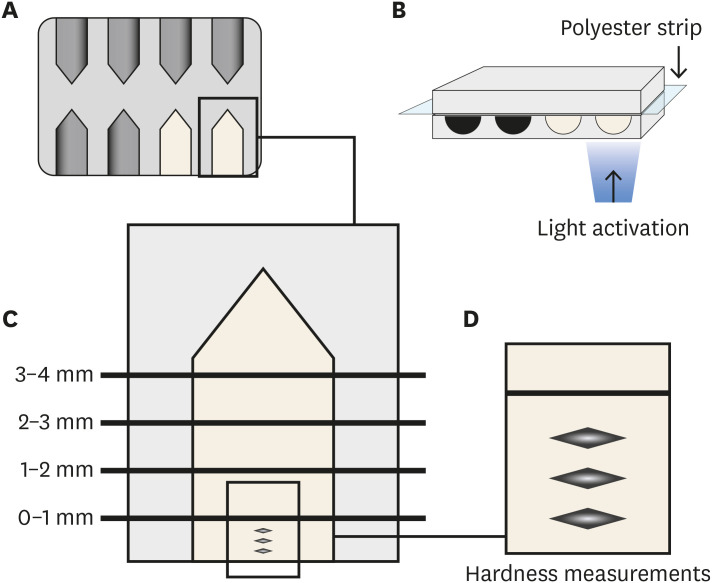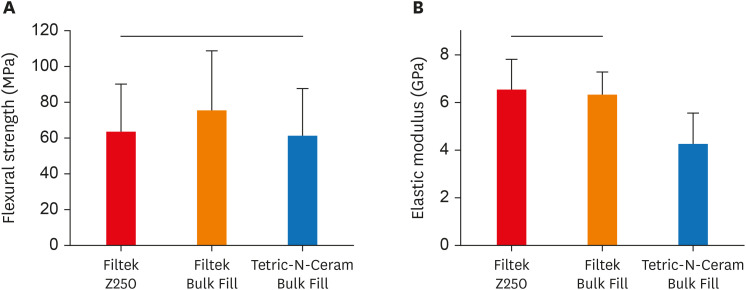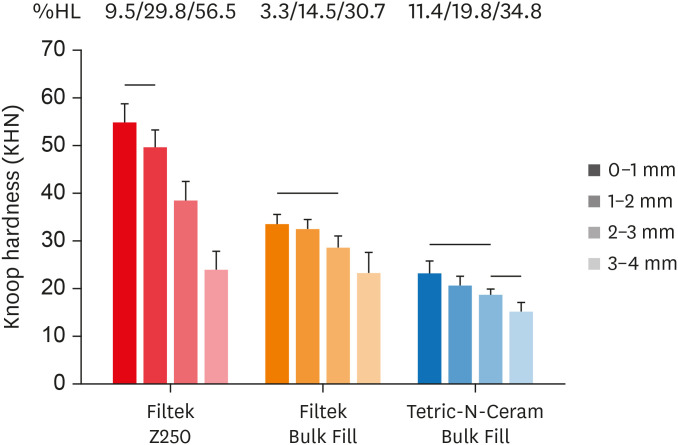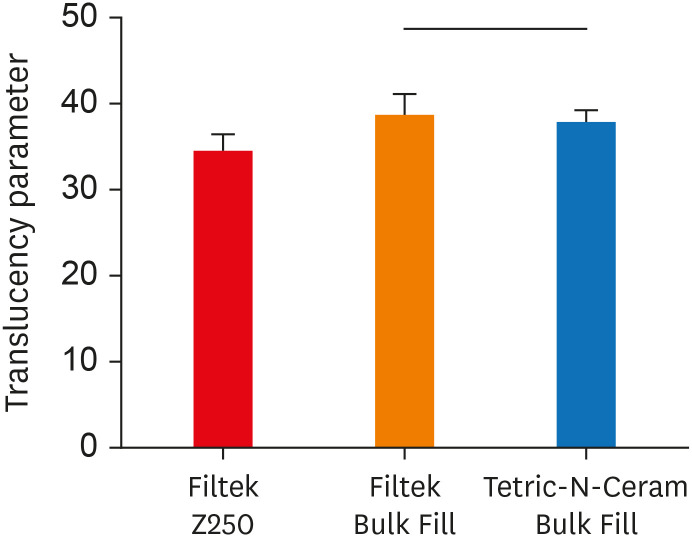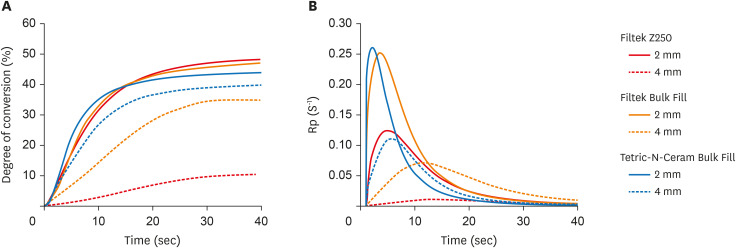Restor Dent Endod.
2021 Aug;46(3):e39. 10.5395/rde.2021.46.e39.
Physicochemical characterization of two bulk fill composites at different depths
- Affiliations
-
- 1Department of Dental Materials, School of Dentistry, Universidad de la República, Montevideo, Uruguay
- 2Laboratory of Dental Materials, Academic Area of Dentistry, Autonomous University of Hidalgo State, Pachuca, México
- 3Graduate Program in Dentistry, Federal University of Pelotas, Pelotas, Brazil
- 4Department of General and Oral Physiology, School of Dentistry, Universidad de la República, Montevideo, Uruguay
- KMID: 2548083
- DOI: http://doi.org/10.5395/rde.2021.46.e39
Abstract
Objectives
This study analyzed the physical-chemical behavior of 2 bulk fill resin composites (BFCs; Filtek Bulk Fill [FBF], and Tetric-N-Ceram Bulk Fill [TBF]) used in 2- and 4-mm increments and compared them with a conventional resin composite (Filtek Z250).
Materials and Methods
Flexural strength and elastic modulus were evaluated by using a 3-point bending test. Knoop hardness was measured at depth areas 0–1, 1–2, 2–3, and 3–4 mm. The translucency parameter was measured using an optical spectrophotometer. Realtime polymerization kinetics was analyzed using Fourier transform infrared spectroscopy.
Results
Flexural strength was similar among the materials, while TBF showed lower elastic modulus (Z250: 6.6 ± 1.3, FBF: 6.4 ± 0.9, TBF: 4.3 ± 1.3). The hardness of Z250 was similar only between 0–1 mm and 1–2 mm. Both BFCs had similar hardness until 2–3 mm, and showed significant decreases at 3–4 mm (FBF: 33.45 ± 1.95 at 0–1 mm to 23.19 ± 4.32 at 3–4 mm, TBF: 23.17 ± 2.51 at 0–1 mm to 15.11 ± 1.94 at 3–4 mm). The BFCs showed higher translucency than Z250. The polymerization kinetics of all the materials were similar at 2-mm increments. At 4-mm, only TBF had a similar degree of conversion compared with 2 mm.
Conclusions
The BFCs tested had similar performance compared to the conventional composite when used in up to 2-mm increments. When the increment was thicker, the BFCs were properly polymerized only up to 3 mm.
Keyword
Figure
Reference
-
1. Garcia D, Yaman P, Dennison J, Neiva G. Polymerization shrinkage and depth of cure of bulk fill flowable composite resins. Oper Dent. 2014; 39:441–448. PMID: 24304339.
Article2. Orłowski M, Tarczydło B, Chałas R. Evaluation of marginal integrity of four bulk-fill dental composite materials: in vitro study. Sci World J. 2015; 2015:701262.3. Ferracane JL. Resin composite--state of the art. Dent Mater. 2011; 27:29–38. PMID: 21093034.
Article4. Benetti AR, Havndrup-Pedersen C, Honoré D, Pedersen MK, Pallesen U. Bulk-fill resin composites: polymerization contraction, depth of cure, and gap formation. Oper Dent. 2015; 40:190–200. PMID: 25216940.
Article5. Krämer N, Lohbauer U, García-Godoy F, Frankenberger R. Light curing of resin-based composites in the LED era. Am J Dent. 2008; 21:135–142. PMID: 18686762.6. Corral Núñez C, Vildósola-Grez P, Bersezio-Miranda C, Alves-Dos Campos E, Fernández Godoy E. Revisión del estado actual de resinas compuestas bulk-fill. Rev Fac Odontol Univ Antioq. 2015; 27:177–196.
Article7. Ferracane JL, Hilton TJ, Stansbury JW, Watts DC, Silikas N, Ilie N, Heintze S, Cadenaro M, Hickel R. Academy of dental materials guidance-resin composites: part II-technique sensitivity (handling, polymerization, dimensional changes). Dent Mater. 2017; 33:1171–1191. PMID: 28917571.
Article8. Nascimento AS, de Lima EA, Durao MA, Sousa YC, Correia TC, Braz R. Marginal microleakage in Bulk Fill resins. Rev Odontol UNESP. 2016; 45:327–331.
Article9. Al-Harbi F, Kaisarly D, Bader D, El Gezawi M. Marginal integrity of bulk versus incremental fill class II composite restorations. Oper Dent. 2016; 41:146–156. PMID: 26266653.
Article10. El-Damanhoury H, Platt J. Polymerization shrinkage stress kinetics and related properties of bulk-fill resin composites. Oper Dent. 2014; 39:374–382. PMID: 23865582.
Article11. Rengo C, Spagnuolo G, Ametrano G, Goracci C, Nappo A, Rengo S, Ferrari M. Marginal leakage of bulk fill composites in class II restorations: a microCT and digital microscope analysis. Int J Adhes Adhes. 2015; 60:123–129.
Article12. Ilie N, Bucuta S, Draenert M. Bulk-fill resin-based composites: an in vitro assessment of their mechanical performance. Oper Dent. 2013; 38:618–625. PMID: 23570302.
Article13. Swift EJ Jr. Critical appraisal: bulk-fill composites, part I. J Esthet Restor Dent. 2015; 27:176–179. PMID: 26032122.14. Khamverdi Z, Fazelian N, Aghaei M. Comparative evaluation of microleakage in class V composite resin restorations using two bulk filled resin composites and one conventional composite (grandio). Ann Dent Spec. 2018; 6:17–22.15. Ilie N, Stark K. Curing behaviour of high-viscosity bulk-fill composites. J Dent. 2014; 42:977–985. PMID: 24887360.
Article16. Czasch P, Ilie N. In vitro comparison of mechanical properties and degree of cure of bulk fill composites. Clin Oral Investig. 2013; 17:227–235.
Article17. Li X, Pongprueksa P, Van Meerbeek B, De Munck J. Curing profile of bulk-fill resin-based composites. J Dent. 2015; 43:664–672. PMID: 25597265.
Article18. International Organization for Standardization. ISO 4049:2009 Dentistry — Polymer based restorative materials. Geneva: International Organization for Standardization;2009.19. de Araújo CS, Schein MT, Zanchi CH, Rodrigues SA Jr, Demarco FF. Composite resin microhardness: the influence of light curing method, composite shade, and depth of cure. J Contemp Dent Pract. 2008; 9:43–50. PMID: 18473026.
Article20. Sharma G, Wu W, Dalal EN. The CIEDE2000 color-difference formula: implementation notes, supplementary test data, and mathematical observations. Color Res Appl. 2005; 30:21–30.
Article21. Herrera-González AM, Caldera-Villalobos M, Pérez-Mondragón AA, Cuevas-Suárez CE, González-López JA. Analysis of double bond conversion of photopolymerizable monomers by FTIR-ATR spectroscopy. J Chem Educ. 2019; 96:1786–1789.
Article22. Moraes RR, Faria-e-Silva AL, Ogliari FA, Correr-Sobrinho L, Demarco FF, Piva E. Impact of immediate and delayed light activation on self-polymerization of dual-cured dental resin luting agents. Acta Biomater. 2009; 5:2095–2100. PMID: 19249263.
Article23. Flury S, Hayoz S, Peutzfeldt A, Hüsler J, Lussi A. Depth of cure of resin composites: Is the ISO 4049 method suitable for bulk fill materials? Dent Mater. 2012; 28:521–528. PMID: 22391146.
Article24. Masouras K, Silikas N, Watts DC. Correlation of filler content and elastic properties of resin-composites. Dent Mater. 2008; 24:932–939. PMID: 18155132.
Article25. Son SA, Park JK, Seo DG, Ko CC, Kwon YH. How light attenuation and filler content affect the microhardness and polymerization shrinkage and translucency of bulk-fill composites? Clin Oral Investig. 2017; 21:559–565.
Article26. Marovic D, Tauböck TT, Attin T, Panduric V, Tarle Z. Monomer conversion and shrinkage force kinetics of low-viscosity bulk-fill resin composites. Acta Odontol Scand. 2015; 73:474–480. PMID: 25543454.
Article27. Leprince JG, Palin WM, Vanacker J, Sabbagh J, Devaux J, Leloup G. Physico-mechanical characteristics of commercially available bulk-fill composites. J Dent. 2014; 42:993–1000. PMID: 24874951.
Article28. Cuevas-Suárez CE, Pimentel-García B, Rivera-Gonzaga A, Álvarez-Gayosso C, Ancona-Meza AL, Grazioli G, Zamarripa-Calderón E. Examining the effect of radiant exposure on commercial photopolimerizable dental resin composites. Dent J (Basel). 2018; 6:55.
Article29. Abed YA, Sabry HA, Alrobeigy NA. Degree of conversion and surface hardness of bulk-fill composite versus incremental-fill composite. Tanta Dent J. 2015; 12:71–80.
Article30. Camassari JR, Correr-Sobrinho L, Correr AB, Puppin-Rontani J, Stipp RN, Puppin-Rontani RM, Paula AB. Physical-mechanical properties of bulk fill composites submitted to biodegradation by Streptococcus mutans . Braz Dent J. 2020; 31:431–439. PMID: 32901721.
Article31. Vojdani M, Bagheri R, Khaledi AA. Effects of aluminum oxide addition on the flexural strength, surface hardness, and roughness of heat-polymerized acrylic resin. J Dent Sci. 2012; 7:238–244.
Article32. Tchorz JP, Doll R, Wolkewitz M, Hellwig E, Hannig C. Microhardness of composite materials with different organic phases in deep class II cavities: an in vitro study. Oper Dent. 2011; 36:502–511. PMID: 21843028.
Article33. Van Ende A, De Munck J, Lise DP, Van Meerbeek B. Bulk-fill composites: a review of the current literature. J Adhes Dent. 2017; 19:95–109. PMID: 28443833.34. Cidreira Boaro LC, Pereira Lopes D, de Souza AS, Lie Nakano E, Ayala Perez MD, Pfeifer CS, Gonçalves F. Clinical performance and chemical-physical properties of bulk fill composites resin -a systematic review and meta-analysis. Dent Mater. 2019; 35:e249–e264. PMID: 31421957.
Article35. Tomaszewska IM, Kearns JO, Ilie N, Fleming GJ. Bulk fill restoratives: to cap or not to cap--That is the question? J Dent. 2015; 43:309–316. PMID: 25625673.36. Bucuta S, Ilie N. Light transmittance and micro-mechanical properties of bulk fill vs. conventional resin based composites. Clin Oral Investig. 2014; 18:1991–2000.
Article37. Lee YK. Influence of filler on the difference between the transmitted and reflected colors of experimental resin composites. Dent Mater. 2008; 24:1243–1247. PMID: 18343494.
Article38. Shortall AC, Palin WM, Burtscher P. Refractive index mismatch and monomer reactivity influence composite curing depth. J Dent Res. 2008; 87:84–88. PMID: 18096900.
Article39. Fujita K, Nishiyama N, Nemoto K, Okada T, Ikemi T. Effect of base monomer's refractive index on curing depth and polymerization conversion of photo-cured resin composites. Dent Mater J. 2005; 24:403–408. PMID: 16279731.
Article40. Garoushi S, Vallittu P, Shinya A, Lassila L. Influence of increment thickness on light transmission, degree of conversion and micro hardness of bulk fill composites. Odontology. 2016; 104:291–297. PMID: 26660101.
Article41. Leprince JG, Palin WM, Hadis MA, Devaux J, Leloup G. Progress in dimethacrylate-based dental composite technology and curing efficiency. Dent Mater. 2013; 29:139–156. PMID: 23199807.
Article42. Fronza BM, Rueggeberg FA, Braga RR, Mogilevych B, Soares LE, Martin AA, Ambrosano G, Giannini M. Monomer conversion, microhardness, internal marginal adaptation, and shrinkage stress of bulk-fill resin composites. Dent Mater. 2015; 31:1542–1551. PMID: 26608118.
Article43. Radebner J, Eibel A, Leypold M, Gorsche C, Schuh L, Fischer R, Torvisco A, Neshchadin D, Geier R, Moszner N, Liska R, Gescheidt G, Haas M, Stueger H. Tetraacylgermanes: highly efficient photoinitiators for visible-light-induced free-radical polymerization. Angew Chem Int Ed Engl. 2017; 56:3103–3107. PMID: 28156043.
Article44. Al-Ahdal K, Ilie N, Silikas N, Watts DC. Polymerization kinetics and impact of post polymerization on the degree of conversion of bulk-fill resin-composite at clinically relevant depth. Dent Mater. 2015; 31:1207–1213. PMID: 26296813.
Article45. Al-Mansour K, Al-Sada A, Al-Sinan H. Curing depth of bulk-fill composites-an in-vitro study. Pak Oral Dent J. 2015; 35:270–274.46. Yap AU, Pandya M, Toh WS. Depth of cure of contemporary bulk-fill resin-based composites. Dent Mater J. 2016; 35:503–510. PMID: 27252008.
Article47. Price RB, Murphy DG, Dérand T. Light energy transmission through cured resin composite and human dentin. Quintessence Int. 2000; 31:659–667. PMID: 11203991.48. Price RB, Dérand T, Loney RW, Andreou P. Effect of light source and specimen thickness on the surface hardness of resin composite. Am J Dent. 2002; 15:47–53. PMID: 12074230.
- Full Text Links
- Actions
-
Cited
- CITED
-
- Close
- Share
- Similar articles
-
- Degree of Conversion and Polymerization Shrinkage of Low and High Viscosity Bulk-Fill Giomer-based and Resin-based composites
- Color Stability of Bulk-Fill Resin Composites after Immersion in Different Media
- Effect of resin thickness on the microhardness and optical properties of bulk-fill resin composites
- Color stability of bulk-fill and incremental-fill resin-based composites polished with aluminum-oxide impregnated disks
- The polymerization efficiency of a bulk-fill composite based on matrixmodification technology

